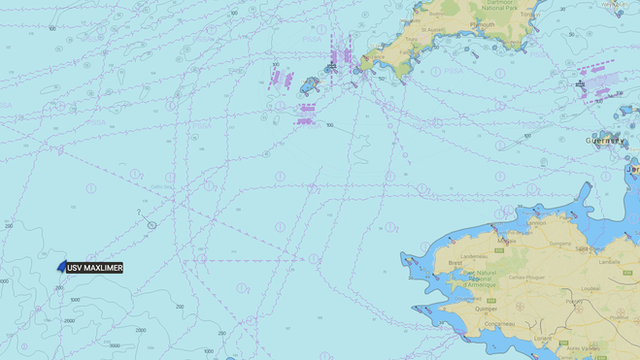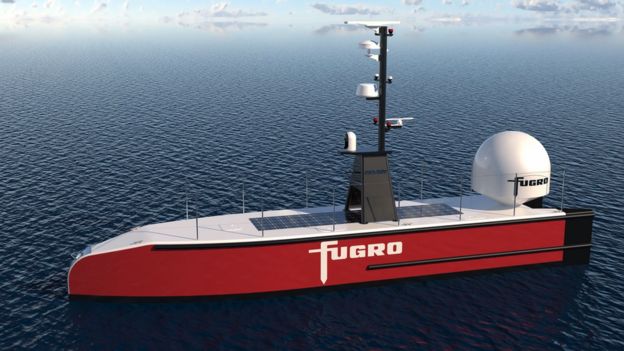A UK boat has just provided an impressive demonstration of the future of robotic maritime operations.
According to a BBC News report,
the 12m Uncrewed Surface Vessel (USV) Maxlimer has completed a 22-day-long mission to map an area of seafloor in the Atlantic.
How did it happen?
SEA-KIT International, which developed the craft, “skippered” the entire outing via satellite from its base in Tollesbury in eastern England.
The mission was part-funded by the European Space Agency.
Robot boats promise a dramatic change in the way we work at sea.
Already, many of the big survey companies that run traditional crewed vessels have started to invest heavily in the new, remotely operated technologies. Freight companies are also acknowledging the cost advantages that will come from running robot ships.
But “over-the-horizon” control has to show it’s practical and safe if it’s to gain wide acceptance. Hence, the demonstration from Maxlimer.
 Image copyright BIGOCEANDATA.COM
Image copyright BIGOCEANDATA.COM- The USV was despatched from Plymouth in late July and sent to a location some 460km (280 miles) to the south-west.
- With a multi-beam echo-sounder attached to its hull, the boat mapped more than 1,000sq km of continental shelf area, down to about a kilometre in depth.
- This was a segment of seafloor that had essentially no modern data registered with the UK Hydrographic Office.
- SEA-KIT had wanted to send the USV across the Atlantic to America for the demonstration, but the Covid-19 crisis made this impossible to organise.
Demonstrating challenging exploration capabilities
“The project’s overall aim was to demonstrate the capabilities of current technologies to survey unexplored or inadequately surveyed ocean frontiers and despite the planning challenges we faced due to Covid-19, I feel that we have done that. We have proven the true over-the-horizon capability of our USV design and the team are exhausted but elated,” the company’s director of technology, Peter Walker, said.
The USV Maxlimer was originally developed for – and won – the Shell Ocean Discovery XPRIZE.
This was a competition to find the next-generation technologies that could be used to map the global ocean floor.
Four-fifths of the sea bottom have yet to be surveyed to an acceptable resolution.
Robotic solutions will be essential if we’re to have any chance of closing the knowledge gap.
 Image copyright SEA-KIT INTERNATIONAL
Image copyright SEA-KIT INTERNATIONALHow does it work?
- Maxlimer makes use of a communications and control system known as Global Situational Awareness via Internet.
- This allows an operator to remotely access CCTV footage, thermal imaging and radar through the vessel, as well as listen live to the USV’s surroundings and even communicate with others in the vicinity.
- Maxlimer links to three independent satellite systems to stay in contact with the control room in Tollesbury.
- The robot boat moves slowly, at up to 4 knots (7km/h; 5mph), but its hybrid diesel-electric propulsion system is highly efficient.
How much fuel does it take?
SEA-KIT CEO and designer, Ben Simpson, told BBC News: “We had a sweepstake on how much fuel would be left in the tank. We thought there was going to be 300-400 litres. It turned out there were 1,300 litres.” In other words, Maxlimer returned to Plymouth with its fuel tank still around a third full.
Partners of this project
As well as the European Space Agency, partners on the project included Global Marine Group, Map the Gaps, Teledyne CARIS, Woods Hole Group and the Nippon Foundation-GEBCO Seabed 2030 initiative.
Another partner was Fugro, one of the world’s biggest marine geotechnical companies. The multinational recently announced a contract with SEA-KIT to purchase a fleet of USVs to use in survey work in the oil, gas and offshore wind sectors.
Did you subscribe to our daily newsletter?
It’s Free! Click here to Subscribe!
Source: BBC News


















Turgut Özal, Dilovası Koltuk Yıkama | PENTA’nın yıkama çözümleri, işletmeler için gerçekten bir kurtarıcı gibi görünüyor. Teşekkürler!
Venster Systems’in pileli sineklikleriyle yaz aylarında keyifli bir şekilde balkonda vakit geçirebiliyoruz, sinekler artık sorun olmaktan çıktı. | Jaluzi Karaman
Plise Sineklik Çeşitleri Tokat | Venster Systems’ retractable insect screens ensure that even the smallest bugs cannot enter, providing a sense of security.
Wat is Padnaam? | Dieser Blog hat mir wirklich geholfen, mehr über die Expertise und Hingabe von MAFA im Bereich Webdesign und Softwareentwicklung zu verstehen. Ich bin sehr beeindruckt.
Ezine Toptan Kadın Giyim | RENE Toptan Tekstil ve Giyim Çözümleri’nde alışveriş yapmak her zaman keyifli bir deneyim. Ürünlerinin kalitesi ve hizmet anlayışları gerçekten takdire şayan.
Kandıra Jaluzi Perde Modelleri | Sineklerle mücadele etmek artık geçmişte kaldı! Venster Systems’in plise sineklikleri bu sorunu kökten çözüyor.
Sinop Jaluzi Perde | Venster Systems’ pleated blinds offer not just style but also practicality. They’ve exceeded our expectations.
Çaykara, Trabzon Jakuzi Fiyatları | Atlas Jakuzi’nin sunduğu ürünler, evimde kendime ayırdığım zamanı daha da özel kılıyor. Teşekkürler!
Saraç İshak / Fatih Beton Kırma | Rüzgar Karot’un sunduğu hizmetten çok memnun kaldım, her aşamada kalite ve güven sağladılar.
Vatpan | MAFA Technology’s content keeps me updated and intrigued.
Pepergea | Ik ben altijd onder de indruk van de kwaliteit en consistentie van MAFA’s werk op het gebied van webdesign en softwareontwikkeling. Ze leveren altijd uitstekende resultaten.
Sanayi Mahallesi, Pendik Karyola Yıkama | PENTA’nın çözümleri, işletmemizin hijyen standartlarını artırmak için harika bir seçenek gibi görünüyor. Teşekkürler!
Hürriyet / Esenyurt Beton Kırma | Rüzgar Karot’un işçilik kalitesi gerçekten dikkat çekici, her detayı özenle işliyorlar.
Beton Parlatma | Sitenizin özgün içerikleri ve derinlemesine analizleri gerçekten etkileyici. Teşekkürler MAFA!
Kabakoz / Şile Beton Kesme | Rüzgar Karot’un profesyonel ekibi ve kaliteli hizmeti sayesinde işlerimi sorunsuz bir şekilde hallettim.
Emirli Mahallesi, Pendik Köşe Takımı Yıkama | PENTA’nın yıkama çözümleriyle ilgili bu yazı, işletmemin temizlik ve hijyen konusundaki ihtiyaçlarını nasıl karşılayabileceğimi daha iyi anlamama yardımcı oldu. Harika bir kaynak!
Ödeme Alma Sistemleri | After reading MAFA’s articles, I feel more empowered to take on new challenges and pursue new opportunities in web design and development. Thank you for the empowerment.
Kepsut Jakuzi Modelleri | Atlas Jakuzi’nin lüks ve şık tasarımlarıyla evimdeki banyo deneyimim tamamen değişti. Teşekkürler!
Çayırova Güvenlik Kamera Sistemleri | MAFA Teknoloji’nin analizleri ve yorumları benim için çok değerli.
Vera | I trust MAFA Technology to provide accurate and relevant information.
Selendi, Manisa Jakuzi | Atlas Jakuzi’nin ürünleriyle evimde bir spa ortamı yaratmak mümkün. Gerçekten harika bir hizmet sunuyorlar!
Reading this article was truly enjoyable. The author’s warm and sincere style of writing made the content even more engaging. | İstanbul Karyola Yıkama
Bu yazıyı okumak gerçekten bir zihin açıcı deneyimdi. Yazarın derinlemesine araştırması ve net ifadeleri sayesinde konuyu daha iyi anladım. | toptan giyim Karesi